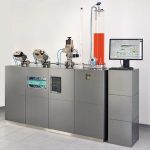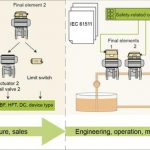Plant planners, builders and operators benefit from the expertise of manu- facturers when selecting individual safety-related components. The companies belonging to the Samson Group for example, develop and manufacture the entire range of final elements from valves and actuators to valve accessories such as positioners, solenoid valves or limit switches. Users can thus trust the components to work as they should.
Authors Marcel Richter Product Management and Marketing for Positioners and Valve Accessories, Samson Monika Schneider Technical Documentation, Samson
In the process industry, a safety-instrumented system (SIS) consists of sensors, a safety-related control system (logic solver) and a final control element. If the safety life cycle of the final element is considered, the clear distribution of roles is evident: manufacturers of safety components develop and manufacture according to IEC 61508. Planners, builders and operators of safety-instrumented systems follow IEC 61511. German users find regulations with practical advice on planning, building and operating safety-instrumented systems in VDI/VDE 2180, which is based on the international IEC 61508 and IEC 61511 standards. The German equivalent stipulates that measures be implemented to prevent systematic and random failures and increase the fault tolerance.
Systematic failures often undetected
Systematic failures have a fundamental effect on the reliability of mechanical components. For the proper selection and sizing of a component, it does not suffice to achieve the required calculated safety integrity level. The component must also be selected so that its operating principle and specifications match the process it is to be used in. Moreover, suitable conditions must be established to ensure that it functions reliably. For example, it is obvious that a safety valve can only provide reliable service on demand if it can fulfil its fail-safe function (i. e. move to the required end position) at any time. This can only be guaranteed if the valve manufacturer’s assembly, installation and operating instructions are ob-served. In addition, no external mechanical influences or temporary events should impair the proper functioning of the safety valve. Systematic failures cannot be expressed statistically. They need to be mastered or excluded by suitable measures as part of a comprehensive functional safety management (FSM) system focused on failure prevention. Nevertheless, undetected systematic failures may occur. One classic example of an undetected systematic failure is a ball valve that has been assembled, installed and started up correctly, but does not perform its fail-safe action on demand because the ball is jammed in its operating position. This can happen if the valve has remained in this position for a long period of time. Suitable counteraction to be taken by plant operators includes testing the proper functioning of the valve at regular intervals du-ring plant shutdowns or performing automatic tests while the process is running, e. g. partial stroke tests (PST). Such measures represent the latest developments in safety engineering and are a reawsonable addition to functional safety management.
Random failures can be expressed
In contrast to systematic failures, random fail-ures can be expressed statistically. These fail-ures cannot be avoided in electronic components; in some cases, they cause the safety function to fail. Random failures of mechanical components are difficult to imagine if the stipulations of the applicable standards are followed by the manufacturer (IEC 61508) and operator (IEC 61511) under a comprehensive safety life cycle approach. Even though random failures hardly ever occur in mechanical components, the standards mandate that they be taken into account. This is mainly done through the dangerous undetected failure rate λDU, which is given in the manufacturer’s specifications. Typical values based on a worst-case estimate for proven-in-use equipment are also found in Namur Recommendation NE 130. The average probability of failure on demand (PFDavg) can be calculated from the dangerous undetected failure rate. The PFDavg value is directly related to the safety integrity level (SIL) described in IEC 61511.
The fault tolerance expresses the capacity of a safety-instrumented system to still perform its fail-safe function if a hardware fault or a software error occurs. One common method of increasing the fault tolerance is to use redundant systems. In redundant safety-instrumented systems, the failure of a single component does not affect the safety function of the entire system as a second component takes over the safety function of the faulty component.
Selection of safety-related components
Plant planners, builders and operators profit from the expertise of manufacturers when selecting individual safety-related components. The companies belonging to the Samson Group for example, develop and manufacture the entire range of final elements from valves and actuators to valve accessories such as positioners, solenoid valves or limit switches. Back in 1995, Samsomatic, a member of the Group, applied for the certification of solenoid valves manufactured in compliance with the then-preliminary DIN V 19251 standard. Since then, these solenoid valves have been proven in use and are now being employed in smart Samson valve accessories. In 2006, Samson launched the Series 3730 Positioner swith emergency shutdown (ESD) function. Since then, Samson equipment has been capable of emergency ventin: the Series 3730 and 3731 Positioners as well as the smart Type 3738 Electronic Limit Switch with integrated solenoid valve and limit contact function.
In December 2011, Samson became one of the first valve manufacturers to have its complete R&D, design, production and sales processes for valves audited by TÜV Süd according to IEC 61508-1. For plant planners and operators, this manufacturer certification has benefits when it comes to attesting prior use according to Namur Recommendation NE 130 as the prior use period is shortened by six months.
Despite the different roles assigned by IEC 61508 and IEC 61511, the company considers itself responsible for supporting operators and providing them with information on functional safety. Samson does this by holding hands-on training and participating in events like the SIL road show that tours Germany. In this connection the authors would like to draw attention to the seminar dealing with control valves and valve accessories used in safety-instrumented systems (SSA). The seminar includes a demonstration of a comprehensive safety-instrumented system and is an excellent opportunity for all participants and trainers from R&D, product management and after-sales service to discuss topics first hand.
cpp-net.com/0314425
Share:








